Performance Retrospective: AMD’s Radeon HD 7970M
by Jarred Walton on June 21, 2013 5:25 PM ESTValue/Medium 1366x768 Gaming Performance
We’ll start off with our “Value” settings, which consist of 1366x768 resolution and roughly Medium detail settings in the tested titles. This represents the sort of settings you’d be likely to use on an iGPU like the HD 7660G or Intel’s HD 4000 (maybe—HD 4600 is possibly a better bet) to get a reasonable >30 FPS out of most titles. Several of the games we’re using now are quite demanding, however, so iGPUs may not be able to provide an acceptable experience unless you really turn down the details and resolution. Here’s what performance looks like:
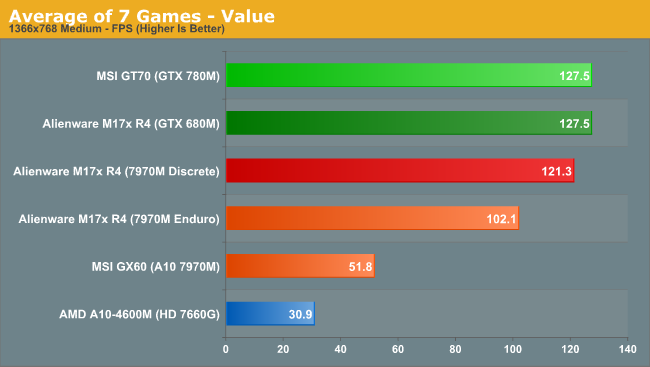

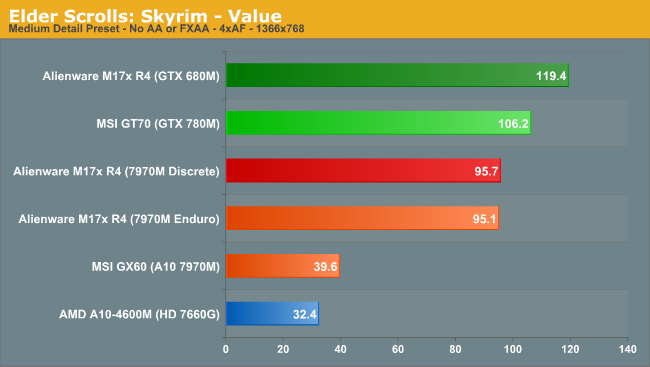

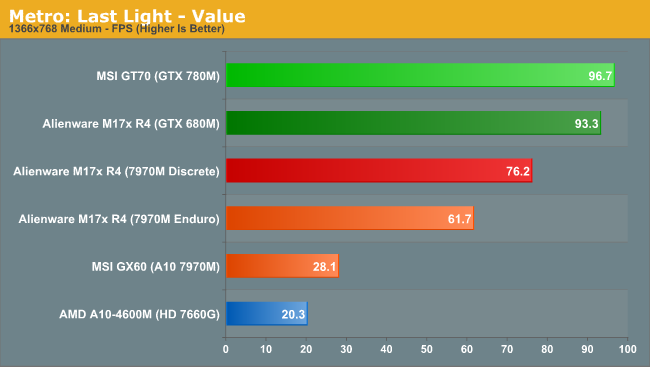

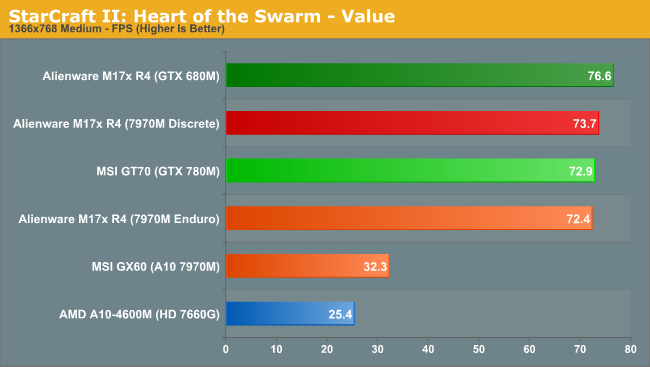
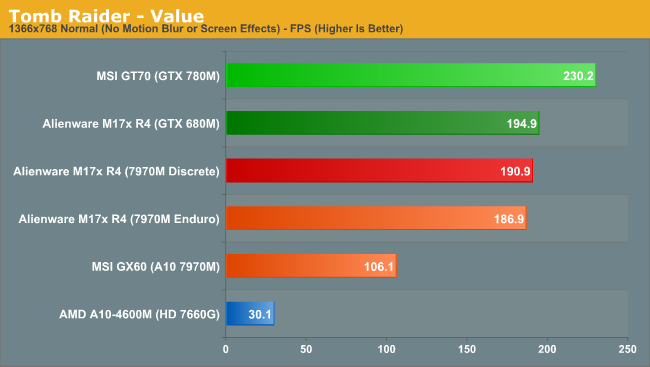
When the HD 7970M first hit notebooks over a year ago, the performance potential seemed lacking compared to the actual hardware. Based on the desktop Pitcairn core, HD 7970M should provide roughly the same performance as the desktop HD 7870 (it’s clocked 15% lower than 7870 on the core, though, so it’s closer to the HD 7850 and GTX 660). The reality is that where the HD 7850 typically competes well against NVIDIA’s desktop GTX 660, on laptops the GTX 680M often blasted the HD 7970M at launch. Many pointed to Enduro as a primary culprit, and while the situation has improved over the past 12 months, even now we can still see a periodic performance deficit from Enduro.
Going over the specifics, on the M17x R4 the discrete mode 7970M ends up being 24% faster in Bioshock, tied in Skyrim, 43% faster in GRID 2, 24% faster in Metro, 54% faster in Sleeping Dogs, tied in StarCraft II, and tied in Tomb Raider. The deficit largely exists in situations where you’re getting >60 FPS, e.g. at lower detail settings and a lower resolution, but that’s obviously not the only factor as Tomb Raider basically elicits no penalty and yet runs at over 180 FPS. While I don’t have the ability to do comparable testing with NVIDIA’s Optimus, I know at one point there were instances where Optimus was slower, but those issues have largely been fixed as far as I can tell. On AMD’s Enduro, that’s clearly not the case with the latest beta drivers.
Incidentally, the bandwidth used to shuttle frames over to the system RAM for display by the iGPU shouldn’t be a limiting factor. Consider as an extreme example a simple graphics benchmark like 3DMark03, where the Wings of Fury test can easily hit >500 FPS at 1366x768. That works out to roughly 2GBps of bandwidth over the PCIe bus, but an x16 slot offers far more bandwidth than that so 2GBps to transfer fames to system RAM shouldn’t present a problem. With the resolutions and frame rates we’re looking at here (a maximum of 1366x768 at <200 FPS), transferring the frames to system RAM uses just 840MBps, so that shouldn’t be a bottleneck.
Moving on to the Intel i7 vs. AMD A10 match up, things are actually worse. We can’t disable Enduro on the GX60, so we’ll just compare Enduro scores for the GX60 and M17x. The Intel platform in this case comes out 79% faster in Bioshock, 140% faster in Skyrim, 85% faster in GRID 2, 120% faster in Metro, 124% faster in Sleeping Dogs, 124% faster in StarCraft II, and 76% faster in Tomb Raider. On average, that works out to a margin of victory of 97%—basically twice as fast. Also of note is that on the GX60, the 7970M is only outperforming the integrated 7660G by 67% on average, so clearly there are other bottlenecks coming into play.
Figuring it was possible the single fan cooling setup in the GX60 is preventing the APU from hitting higher Turbo Core speeds, I logged the various clock speeds using HWiNFO64 and ran through the Bioshock Infinite and Skyrim (extended duration) benchmarks. Maximum CPU clocks reported throughout testing were at a steady 2.7GHz; the APU definitely didn’t hit maximum Turbo Core, but that's only for single-threaded workloads and the 2.7GHz clock is for two or more threads; regardless, it’s not running at the base 2.3GHz, so Turbo or throttling isn't the problem. Similarly, APU temperatures remained below 70C throughout testing, so cooling isn’t limiting performance either. Richland is supposed to be better about hitting its maximum turbo speeds, so potentially that alone could enable it to be 10-15% faster in games like Skyrim and StarCraft II, but the 2-thread turbo speed of Richland is probably similar to Trinity so the gain could prove to be less than 5%. GPU utilization of the HD 7970M during these tests was also rather low at around 35-55%, which isn’t all that uncommon at lower detail settings when the GPU isn’t being pushed hard. Whatever the cause, the fact is that at medium detail settings in most games, the A10-4600M (possibly in combination with Enduro) appears to be a bottleneck on the HD 7970M’s performance.
Wrapping up our look at the Value/Medium settings, if we compare NVIDIA vs. AMD there’s not a lot to say. At these settings, the 680M, 7970M, and 780M are basically taking a siesta. On average, the 680M ends up 5% faster than the best 7970M result and the 780M is tied with the 680M. Looking at individual game results there’s a bit more variation, however. Against the 680M, the 7970M (discrete mode) is generally quite close, with AMD getting minor victories in Bioshock and Sleeping Dogs; minor losses in GRID 2, StarCraft II, and Tomb Raider; and larger 20-25% losses in Skyrim and Metro. The GTX 780M numbers aren't too meaningful, thanks to the test system issues, but Tomb Raider immediately stands out as a game that does't appear to hit the CPU much at all.The 780M is actually slower than the 680M in some of the tests, but it does pull off a 21% lead over the 7970M in Tomb Raider—a game that tends to be very GPU intensive and very light on the CPU.










58 Comments
View All Comments
kogunniyi - Saturday, June 22, 2013 - link
The question of liability is not that simple.I assume that most people who buy the GX60 expect a CPU bottleneck within certain limits. Imagine that the A10-4600m cuts performance in half for every application. If the 7970m is performing at 10% of its potential, the APU is probably not the only problem. Even Enduro does not account for such a performance hit. Most people would define "getting money's worth" as taking the 50% hit in every game. In the case given, they are not getting their money's worth, and the locked-down overclocking does not help.
On the other hand, MSI does not advertise a certain performance. You could argue that the benchmarks it posted for the GX60 are misleading, but that's marketing fluff and should not be taken seriously. Because MSI does not promise anything, it isn't legally responsible, but it can be held ethically accountable: the very act of offering the APU + 7970m suggests that it is a stable and consistent platform. I assume that Jarred simply wants to tell readers that the MSI GX60 may not perform up to standard.
kallogan - Friday, June 21, 2013 - link
7970M is da best considering its lower price. I didn't think the A10 would be such a bottleneck even at 1080p.Wreckage - Friday, June 21, 2013 - link
Waste of money. Lower price because of lower quality.Xinn3r - Saturday, June 22, 2013 - link
+1You can't get away with low quality just by lowering your price
Meaker10 - Friday, June 21, 2013 - link
2.7ghz is the maximum turbo speed for more than 2 threads on the 4600M APU. 3.2ghz is mostly for single thread only.JarredWalton - Friday, June 21, 2013 - link
True. I guess I was expecting some of the games to not hit the second thread hard enough to trigger that limit. Let me edit text a bit....Meaker10 - Friday, June 21, 2013 - link
Engineering cpus are unlocked, if amd had allowed overclocking on platforms like the msi and could be run around 3.5ghz performance would be far more acceptable imo.Khenglish - Saturday, June 22, 2013 - link
Yeah I agree. I don't understand why the top end APU is completely locked. AMD is going for performance/cost, and allowing overclocking would have helped that. 2.7ghz is OK for intel, but for AMD's lower IPC it's a problem. They don't even let you overclock trinity's GPU on laptops.As for the argument that it's to make sure people don't kill their hardware, on the APU laptop I played around with it was possible to disable thermal throttling, thermal shutdown (only possible due to BIOS bug, but still), and the cpu fan though PCI config space options... but overclocking was locked down tight!
Roland00Address - Saturday, June 22, 2013 - link
Furthermore you if you are using more than 2 threads you are using both cores and cmt simultaneously, thus you will use the cmt tax and only get 80% performance.Bob Todd - Friday, June 21, 2013 - link
While the end result for the Enduro drivers on older systems is exactly the weak sauce I expected, I have to say I'm disappointed in how they handled it from a product management perspective. They should have only included systems they absolutely knew they would support (IVB/Trinity), and actually been realistic about previous gen platforms and said something like "We are evaluating the potential for SB/Llano support and we'll have an answer for you in 6 months" (or whatever a realistic timeline would have been). Instead they basically strung along their customers of the older platforms for months with 'a future driver will support your system' pipe dream. Middle finger to you for that one PMs or marketing folks. Who I feel even worse for than Sandy Bridge/(rebadged) 7XXX owners are folks in the same boat with Llano. Those are customers who invested in an ALL AMD solution and these jokers can't even invest in a solution for them? That's bush league AMD.